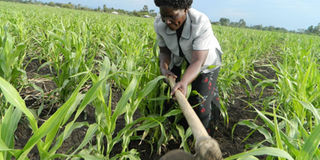Good policies can spur economic growth

Ms Jane Kisia in her sorghum farm at Kano west Irrigation scheme in Kisumu County. Last year, sorghum received a lifeline with the review of the excise tax for beers manufactured using 75 percent locally sourced sorghum, millet or cassava, reviving its demand and renewing hope for over 30,000 small scale farmers initially recruited into the programme. PHOTO | MOSES ODHIAMBO |
What you need to know:
- Kenya’s Vision 2030 identifies agriculture as one of the key sectors to deliver sustainable economic growth and improved livelihoods in rural areas.
- Sorghum is today classified as one of Kenya’s main food crops, alongside maize, rice, wheat, potatoes, cassava, vegetables and beans.
- Last year, sorghum received a lifeline with the review of the excise tax for beers manufactured using 75 percent locally sourced sorghum, millet or cassava, reviving its demand and renewing hope for over 30,000 small scale farmers initially recruited into the programme, close to 100 keg distributors and 12,000 retailers.
- Today KBL’s annual demand is 22,000 metric tonnes, 944 percent increase over the last financial year with projected farmer revenues estimated at Sh700 million.
- Since July 2015, for example, the value chain has directly created over 98,000 jobs at various levels; production (farmers), logistics (handling and transport), manufacturing as well as distribution and retail and more importantly provided consumers with a safe and hygienic alternative to the dangerous illicit brews.
Most sub-Saharan African countries depend on agriculture for survival, making the sector one of the most fundamental drivers of growth, overcoming poverty, and enhancing food security.
Kenya’s Vision 2030 identifies agriculture as one of the key sectors to deliver sustainable economic growth and improved livelihoods in rural areas.
Although Kenya’s agricultural sector accounts for nearly a quarter of the country’s Gross Domestic Product (GDP), the agro-processing sub-sector still contributes only 3.2 percent of GDP.
The turnaround to this equation lies in policy support instruments and continuous investment in local agriculture especially through small scale farmers.
DEVELOPMENT STRATEGY
The Agricultural Sector Development Strategy (ASDS), 2010-2020 aims to increase Kenya’s agricultural productivity, commercialisation and competitiveness.
Before this policy was developed, agricultural policy mainly focused on cash crops rather than staple food crops.
However, with the sector’s challenges in production due to frequent and prolonged drought, more resistant crops like sorghum are increasingly being propelled to address the issue of climate change and adaptation, food security and poverty alleviation.
Sorghum is today classified as one of Kenya’s main food crops, alongside maize, rice, wheat, potatoes, cassava, vegetables and beans.
It is typically grown by small-scale, resource-poor farmers and was mainly used for home consumption until brewing commercialised its demand in 2009.
Following the 2013 tax increase on sorghum brewed beer that led to the fall in demand for sorghum, the farmer population shrank to a paltry 2,500 with the crop output declining 84 percent to 2,060 metric tonnes.
EXCISE TAX REVIEW
Last year, sorghum received a lifeline with the review of the excise tax for beers manufactured using 75 percent locally sourced sorghum, millet or cassava, reviving its demand and renewing hope for over 30,000 small scale farmers initially recruited into the programme, close to 100 keg distributors and 12,000 retailers.
Today KBL’s annual demand is 22,000 metric tonnes, 944 percent increase over the last financial year with projected farmer revenues estimated at Sh700 million.
Since July 2015, for example, the value chain has directly created over 98,000 jobs at various levels; production (farmers), logistics (handling and transport), manufacturing as well as distribution and retail and more importantly provided consumers with a safe and hygienic alternative to the dangerous illicit brews.
Key to sustaining sorghum production will be strategies to increase productivity, enhance quality and expand markets access.
Beyond market guarantee, KBL, through its agriculture arm, East African Maltings Limited, continues to offer structured capacity building and contract growing support to farmers and agents.
PUBLIC-PRIVATE PARTNERSHIP
Our approach to building a thriving sorghum production value chain is based on public-private partnership model.
Working with institutions such as Kenya Agricultural and Livestock Research Organisation (Kalro), we have already boosted production and supply of certified gadam and sila variety seeds.
Since the launch of this partnership, other important players such as the ministry of Agriculture, the county administrations, smart logistics (harvest aggregation) and commercial banks (financing) with networks across the country have made significant contribution to the sorghum value chain.
Not only has this model encouraged local production of high-quality sorghum but it has also provided a sustainable platform for socio-economic empowerment for the smallholder farmers from the arid and semi-arid regions.
Jane Karuku is the managing director, Kenya Breweries Limited





